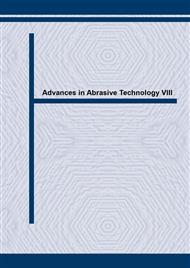p.73
p.81
p.85
p.91
p.97
p.103
p.109
p.115
p.121
Analysis of Grinding Temperature Considering Surface Generation Mechanism
Abstract:
Grinding temperature was analyzed considering heat generation by cutting with each abrasive on the wheel working periphery. A geometrical analysis of interference between the abrasives and workpiece gave the instantaneous cutting cross section, and visualized the surface topography generated by the time. Using the specific grinding energy and the instantaneous cutting cross sections, the instantaneous distribution of heat generation on the wheel-workpiece contact area was obtained. Then grinding temperature was calculated for a given heat partition into the workpiece. Since a cutting with an abrasive generated an impulse of heat flux, temperature distribution calculated for grinding carbon tool steel varied drastically, and very high local temperature or temperature spikes appeared.
Info:
Periodical:
Pages:
97-102
Citation:
Online since:
August 2005
Authors:
Price:
Сopyright:
© 2005 Trans Tech Publications Ltd. All Rights Reserved
Share:
Citation:


